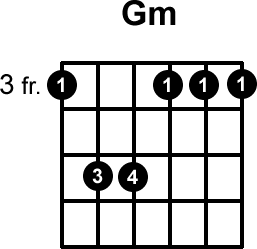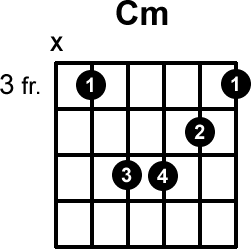After introducing the major chords, its time to move on to the minor chords. Minor chords have a sadder sound when played on their own and are also a main staple in western music. Despite having a sadder sound, they are used in many major keys and happy pieces of music when combined with other chords. As before here are some box diagrams for a few of them:
Looking at the diagrams first off, you will notice that the C and G minor diagrams look a bit different. They have more than one note, or black dots with the same finger number. First of all lets pay attention to that number on the side. In the case of both the C minor and G minor it is saying ‘3rd’. This means, this is the 3rd fret. Notice that thick bar representing the nut of the neck is absent? That’s because the diagram is representing a different part of the neck. In this case an area further down as indicated by the ‘3rd’ beside the diagram.
Now what is with the multiple notes telling you to use the same finger?
First lets look at C minor
It basically means use your index finger and lay it across the neck. In order to play all those notes with one finger, we have to use the index finger and ‘barre’ it across the neck pressing all those notes down. These chords that require a barre are called unsurprisingly barre chords! So examining the C minor chord we can see the barre needs to press on the 3rd fret of the A and e string.
But if we use our index finger and lay it flat on the neck to play all of these notes wont we also be pressing down the D, g and b strings? Yes we will, but that won’t effect the chord since these notes played by the barre on the D, g and b strings will be cancelled out by other notes played your other fingers. So looking at the diagram for that C minor we can see its telling us to play the 3rd fret of the A and e string using a barre. We know its asking for a barre since they both tell use to use the same index finger for both. And with our remaining fingers we need to finish off the chord.
Now lets look at G minor
Notice that the ‘barre’ has many more black dots on it now. Meaning these notes need to be pressed down by the bar. So unlike C minor where the bar only needed to sound two notes cleanly, this G minor requires the ‘barre’ to play cleanly, 4 notes. This is much more difficult.
Now with both these C minor and G minor chords playing the ‘barre’ is only the first step. With the rest of your fingers we need to play the remaining notes as indicated.
This may seem difficult at first, but there is a method to this madness.
It is possible to play both a C minor and G minor in another position close to the nut akin to the other chords that don’t require a ‘barre’. But trust us, you don’t want to learn those, at least not yet. No matter how hard right now you think playing the barre might be, its far easier than the alternative methods to play both these chords.
Here are sound examples of both the C minor and G minor
If its not sounding right, hold the entire chord, and go through each string one by one to identify the culprit. And then apply the same tips from the Major chord chapter.
What if the bad notes are coming from the barre?
In this case you need to experiment with the positioning of your index finger. Depending on the width and bow of your guitars fret board and the size and shape of your finger, you need to find a way for your index finger to sit on the strings and play the notes cleanly. Get your index finger as close to the fret as possible. Are there arches in you finger joints that aren’t pressing strings? shift your finger slightly, try rolling it slightly to its side. Basically you’ll need to experiment with this.
IMPORTANT – as with all chords and all guitar playing, it shouldn’t cause discomfort. If your barre is sounding nice but your hand feels bent unnaturally and uncomfortable then adjust. Aim in all things to play notes cleanly whilst at the SAME time feeling comfortable.
IMPORTANT – this leads on from the previous point. Light pressure. Find a way to play that ‘barre’ that sounds the notes cleanly but doesn’t require you to press hard. With anything in guitar, if you need to press hard to get notes to ring then you need to adjust. It’s just wasted effort. All things in guitar can be played with light pressure.
To demonstrate this we’re going to place an index finger across all six strings on the first fret and sound all the notes cleanly, whilst pressing the strings only lightly,
Give it a try.
So if you can play six notes in a barre cleanly, playing the remaining notes from the C minor and G minor is much less trouble.
When it boils down to it, its just going to take some adjustment to get it right.
There is a very important use for these Barre chords other than playing these two chords but we won’t worry about that just yet. That will be explained in another section.
Okay after all the trouble of playing the barre chords, the open chords should be easier for you as they are similar to the major chords you already know. In fact, the difference between a Major and minor chord is only one note. But don’t worry about that to much now. That will be explained in the intervals lesson. Concentrate on playing for now.
Open chords are called open because you use open strings to play them. Open as in we’re not pressing on any frets.
Once we’ve got those minor chords learnt its time to practice switching between chords. As before try to switch smoothly and cleanly between these minor chords. But also, try to switch between the major chords you’ve already learnt and these new minor chords in as many combinations as you can think of.
Here are some exercises, these are followed in just the same way as the major chord lesson previously. Each example repeats twice.
|C / / /|Am / / /|Em / / /|G / / /|
Try to think up some of your own. Try to include both major and minor chords.
Good Luck!
- Minor chords have a more sad sound.
- Apply the same techniques to play minor chords as the major chords.
- C minor and G minor need to be played with a barre.


